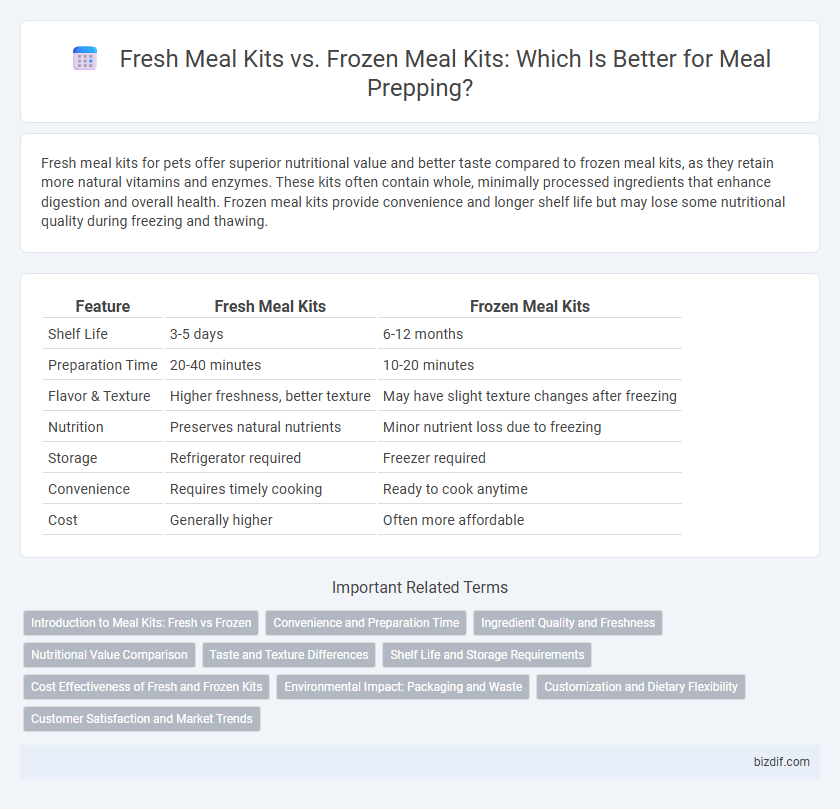Fresh meal kits for pets offer superior nutritional value and better taste compared to frozen meal kits, as they retain more natural vitamins and enzymes. These kits often contain whole, minimally processed ingredients that enhance digestion and overall health. Frozen meal kits provide convenience and longer shelf life but may lose some nutritional quality during freezing and thawing.
Table of Comparison
| Feature | Fresh Meal Kits | Frozen Meal Kits |
|---|---|---|
| Shelf Life | 3-5 days | 6-12 months |
| Preparation Time | 20-40 minutes | 10-20 minutes |
| Flavor & Texture | Higher freshness, better texture | May have slight texture changes after freezing |
| Nutrition | Preserves natural nutrients | Minor nutrient loss due to freezing |
| Storage | Refrigerator required | Freezer required |
| Convenience | Requires timely cooking | Ready to cook anytime |
| Cost | Generally higher | Often more affordable |
Introduction to Meal Kits: Fresh vs Frozen
Fresh meal kits offer pre-portioned, raw ingredients designed for immediate cooking, ensuring optimal flavor and nutritional value. Frozen meal kits provide convenience and longer shelf life by preserving ingredients at low temperatures, allowing for easy storage and reduced food waste. Choosing between fresh and frozen meal kits depends on preferences for freshness, preparation time, and storage capabilities.
Convenience and Preparation Time
Fresh meal kits offer the advantage of quicker preparation times, typically requiring 15 to 30 minutes to cook, making them ideal for those seeking convenience without sacrificing flavor. Frozen meal kits provide extended shelf life and the convenience of long-term storage, but usually demand longer cooking or reheating periods, often ranging from 25 to 45 minutes. Choosing between fresh and frozen meal kits largely depends on one's schedule flexibility and preference for immediate freshness versus storage convenience.
Ingredient Quality and Freshness
Fresh meal kits offer superior ingredient quality and freshness, using seasonal vegetables and high-quality proteins sourced locally to ensure peak flavor and nutrient retention. Frozen meal kits, while convenient and longer-lasting, often rely on ingredients that are flash-frozen shortly after harvest, preserving nutrients but sometimes sacrificing texture and taste. For optimal ingredient freshness and sensory experience, fresh meal kits generally provide a more vibrant and natural eating experience.
Nutritional Value Comparison
Fresh meal kits retain higher levels of essential vitamins and antioxidants due to minimal processing and short time from harvest to consumption. Frozen meal kits often experience nutrient degradation, particularly in water-soluble vitamins like vitamin C and B-complex, though freezing preserves most macronutrients effectively. Selecting fresh meal kits generally ensures superior nutritional profiles, supporting optimal dietary intake for meal prepping enthusiasts.
Taste and Texture Differences
Fresh meal kits offer superior taste and texture by preserving natural flavors and crispness through minimal processing, resulting in vibrant, expertly balanced dishes. Frozen meal kits may experience slight nutrient loss and texture changes such as sogginess or softness due to freezing and thawing but maintain convenience and longer shelf life. Sensory evaluations often reveal fresh kits provide a more enjoyable and authentic eating experience compared to their frozen counterparts.
Shelf Life and Storage Requirements
Fresh meal kits typically have a shorter shelf life of about 3-5 days and require refrigeration at temperatures between 34degF to 40degF to maintain freshness. Frozen meal kits can be stored for several months, usually up to 6-12 months, when kept at consistent freezing temperatures below 0degF, allowing for longer-term storage and reduced food waste. Proper storage conditions are crucial for both types to preserve nutritional quality and safety.
Cost Effectiveness of Fresh and Frozen Kits
Fresh meal kits often come with higher upfront costs due to premium ingredients and shorter shelf life, making them less cost-effective for long-term meal planning. Frozen meal kits provide significant savings by reducing food waste and allowing bulk purchasing, which lowers per-meal expenses. Evaluating cost effectiveness depends on individual consumption patterns, but frozen kits generally offer more budget-friendly options without sacrificing nutritional value.
Environmental Impact: Packaging and Waste
Fresh meal kits typically use biodegradable or recyclable packaging materials, reducing landfill waste and lowering carbon emissions associated with plastic production. Frozen meal kits often require more insulating materials and plastic components to maintain cold temperatures during transit, contributing to higher packaging waste and energy consumption. Choosing fresh meal kits can significantly minimize environmental impact by cutting down on non-recyclable packaging and reducing overall waste generation.
Customization and Dietary Flexibility
Fresh meal kits offer greater customization options by allowing customers to select and adjust ingredients based on dietary preferences such as gluten-free, keto, or vegan diets. Frozen meal kits, while convenient, often come with limited flexibility due to pre-portioned ingredients and fixed recipes. Dietary flexibility is higher with fresh meal kits as they enable modifications to accommodate allergies and nutritional goals more precisely.
Customer Satisfaction and Market Trends
Fresh meal kits consistently receive higher customer satisfaction ratings due to their superior taste, nutritional value, and perceived quality compared to frozen meal kits. Market trends indicate a growing demand for fresh meal kits, driven by health-conscious consumers seeking convenience without compromising freshness. Despite convenience and longer shelf life favoring frozen kits, the premium segment's expansion highlights a clear preference for fresh options within the meal kit industry.
Fresh meal kits vs frozen meal kits Infographic

 bizdif.com
bizdif.com